Decomposition Analysis in Decoupling Transport Output from Carbon Emissions in Guangdong Province, China
Abstract
:1. Introduction
2. Materials and Methods
2.1. Data Sources and Processing
2.2. Decomposition Model of Energy-Related Carbon Emission
2.3. Decoupling Index
- D ≥ 1 denoting strong decoupling effort;
- 0 < D < 1 denoting weak decoupling effort;
- D ≤ 0 denoting no decoupling effort.
3. Results
3.1. Analysis on Carbon Emissions
3.1.1. Macro-Level: Energy-Related Carbon Emissions of Transport
3.1.2. Micro-Level: Energy Intensity and Structure
3.2. Analysis on Decoupling Indexes
3.2.1. Decoupling Elasticity
3.2.2. Decomposition Analysis
3.2.3. Decoupling Effort
4. Discussion
4.1. Overview of the Decoupling
4.2. Tertiary Industrial Structure
4.3. Time Issues of the Model: Baseline and Time Scale
4.4. Five-Year Periodic Pattern
4.4.1. Periodic Variation of Each Plan
4.4.2. Variation of the Inter-Plans
4.4.3. Summary
5. Conclusions
Acknowledgments
Author Contributions
Conflicts of Interest
Abbreviations
| CE | Carbon emissions; |
| TCE | Transport carbon emissions; |
| GHG | Greenhouse gas; |
| OECD | Organization for Economic Cooperation and Development |
| LMDI | Logarithmic Mean Divisia Index; |
| i | The type of energy; |
| E | Final energy consumption in transport; |
| TO | Transport output; |
| SO | Service industry (tertiary industry) output; |
| ES | Energy structure; |
| I | Energy intensity; |
| IS | Industrial structure; |
| TS | Tertiary industrial structure; |
| G | GDPPC, GDP per capita; |
| P | Total permanent resident population in Guangdong; |
| WD | Weak decoupling; |
| SD | Strong decoupling; |
| EC | Expansive coupling; |
| END | Expansive negative decoupling; |
| LPG | Liquid petroleum gas; |
| LNG | Liquid natural gas. |
Appendix
| Decoupling Elasticity Value (ε) | ΔCE/CE | ΔTO/TO | Decoupling State | Abbreviation |
|---|---|---|---|---|
| ε < 0 | <0 | >0 | Strong decoupling 2 | SD |
| 0 ≤ ε ≤ 0.8 | >0 | >0 | Weak decoupling 2 | WD |
| 0.8 ≤ ε ≤ 1.2 | >0 | >0 | Expansive coupling 1 | EC |
| ε > 1.2 | >0 | >0 | Expansive negative decoupling 3 | END |
| ε < 0 | >0 | <0 | Strong negative decoupling 3 | SND |
| 0 ≤ ε ≤ 0.8 | <0 | <0 | Weak negative decoupling 3 | WND |
| 0.8 ≤ ε ≤ 1.2 | <0 | <0 | Recessive coupling 1 | RC |
| ε > 1.2 | <0 | <0 | Recessive decoupling 2 | RD |
References
- Talukdar, D.; Meisner, C.M. Does the private sector help or hurt the environment? Evidence from carbon dioxide pollution in developing countries. World Dev. 2001, 29, 827–840. [Google Scholar] [CrossRef]
- Zhang, L.; Huang, Y.X.; Li, Y.M.; Cheng, X.L. An investigation on spatial changing pattern of CO2 emissions in china. Resour. Sci. 2010, 32, 211–217. [Google Scholar]
- Yu, S.; Ma, C.; Wang, T.; Li, X. Preliminary comment on “Reduced carbon emission estimates from fossil fuel combustion and cement production in China“. Energy China 2015, 37, 27–31. (In Chinese) [Google Scholar]
- Zhou, N.; Levine, M.D.; Price, L. Overview of current energy-efficiency policies in china. Energy Policy 2010, 38, 6439–6452. [Google Scholar] [CrossRef]
- Zhou, G.; Chung, W.; Zhang, X. A study of carbon dioxide emissions performance of China’s transport sector. Energy 2013, 50, 302–314. [Google Scholar] [CrossRef]
- Wang, W.; Kuang, Y.; Huang, N. Study on the decomposition of factors affecting energy-related carbon emissions in Guangdong Province, China. Energies 2011, 4, 2249–2272. [Google Scholar] [CrossRef]
- Wang, W.; Kuang, Y.; Huang, N.; Zhao, D. Empirical research on decoupling relationship between energy-related carbon emission and economic growth in Guangdong Province based on extended kaya identity. Sci. World J. 2014, 2014, 782750. [Google Scholar] [CrossRef] [PubMed]
- Kiang, N.; Schipper, L. Energy trends in the Japanese transportation sector. Transp. Policy 1996, 3, 21–35. [Google Scholar] [CrossRef]
- Zachariadis, T. On the baseline evolution of automobile fuel economy in europe. Energy Policy 2006, 34, 1773–1785. [Google Scholar] [CrossRef]
- Michaelis, L.; Davidson, O. GHG mitigation in the transport sector. Energy Policy 1996, 24, 969–984. [Google Scholar] [CrossRef]
- Kwon, T.H. The determinants of the changes in car fuel efficiency in great britain (1978–2000). Energy Policy 2006, 34, 2405–2412. [Google Scholar] [CrossRef]
- Stead, D. Transport intensity in Europe—Indicators and trends. Transp. Policy 2001, 8, 29–46. [Google Scholar] [CrossRef]
- Preston, J. Integrating transport with socio–economic activity—A research agenda for the new millennium. J. Transp. Geogr. 2001, 9, 13–24. [Google Scholar] [CrossRef]
- Tapio, P.; Banister, D.; Luukkanen, J.; Vehmas, J.; Willamo, R. Energy and transport in comparison: Immaterialisation dematerialisation and decarbonisation in the eu15 between 1970 and 2000. Energy Policy 2007, 35, 433–451. [Google Scholar] [CrossRef]
- Chung, W.; Zhou, G.; Yeung, I.M.H. A study of energy efficiency of transport sector in China from 2003 to 2009. Appl. Energy 2013, 112, 1066–1077. [Google Scholar] [CrossRef]
- Tirumalachetty, S.; Kockelman, K.M.; Nichols, B.G. Forecasting greenhouse gas emissions from urban regions: Microsimulation of land use and transport patterns in Austin, Texas. J. Transp. Geogr. 2013, 33, 220–229. [Google Scholar] [CrossRef]
- Xu, B.; Lin, B. Carbon dioxide emissions reduction in China's transport sector: A dynamic var (vector autoregression) approach. Energy 2015, 83, 486–495. [Google Scholar] [CrossRef]
- Papagiannaki, K.; Diakoulaki, D. Decomposition analysis of CO2 emissions from passenger cars: The cases of greece and Denmark. Energy Policy 2009, 37, 3259–3267. [Google Scholar] [CrossRef]
- Baldwin, J.G.; Wing, I.S. The spatiotemporal evolution of us carbon dioxide emissions: Stylized facts and implications for climate policy. J. Reg. Sci. 2013, 53, 672–689. [Google Scholar]
- Kang, Y.Q.; Zhao, T.; Wu, P. Impacts of energy-related CO2 emissions in China: A spatial panel data technique. Nat. Hazards 2016, 81, 405–421. [Google Scholar] [CrossRef]
- Yuan, L.; Pan, J. Disaggregation of carbon emission drivers in kaya identity and its limitations with regard to policy implications. Adv. Clim. Chang. Res. 2013, 9, 210–215. [Google Scholar]
- Andreoni, V.; Galmarini, S. Decoupling economic growth from carbon dioxide emissions: A decomposition analysis of Italian energy consumption. Energy 2012, 44, 682–691. [Google Scholar] [CrossRef]
- De Freitas, L.C.; Kaneko, S. Decomposing the decoupling of CO2 emissions and economic growth in Brazil. Ecol. Econ. 2011, 70, 1459–1469. [Google Scholar] [CrossRef]
- Diakoulaki, D.; Mandaraka, M. Decomposition analysis for assessing the progress in decoupling industrial growth from CO2 emissions in the eu manufacturing sector. Energy Econ. 2007, 29, 636–664. [Google Scholar] [CrossRef]
- Hatzigeorgiou, E.; Polatidis, H.; Haralambopoulos, D. CO2 emissions, gdp and energy intensity: A multivariate cointegration and causality analysis for Greece, 1977–2007. Appl. Energy 2011, 88, 1377–1385. [Google Scholar] [CrossRef]
- Kang, J.D.; Zhao, T.; Ren, X.S.; Lin, T. Using decomposition analysis to evaluate the performance of China’s 30 provinces in CO2 emission reductions over 2005–2009. Nat. Hazards 2012, 64, 999–1013. [Google Scholar] [CrossRef]
- Liang, S.; Liu, Z.; Crawford-Brown, D.; Wang, Y.; Xu, M. Decoupling analysis and socioeconomic drivers of environmental pressure in china. Environ. Sci. Technol. 2014, 48, 1103–1113. [Google Scholar] [CrossRef] [PubMed]
- Tapio, P. Towards a theory of decoupling: Degrees of decoupling in the eu and the case of road traffic in finland between 1970 and 2001. Transp. Policy 2005, 12, 137–151. [Google Scholar] [CrossRef]
- Wang, W.; Liu, R.; Zhang, M.; Li, H. Decomposing the decoupling of energy-related CO2 emissions and economic growth in jiangsu province. Energy Sustain. Dev. 2013, 17, 62–71. [Google Scholar] [CrossRef]
- Fouquet, R. Trends in income and price elasticities of transport demand (1850–2010). Energy Policy 2012, 50, 62–71. [Google Scholar] [CrossRef]
- Lu, Q.; Yang, H.; Huang, X.; Chuai, X.; Wu, C. Multi-sectoral decomposition in decoupling industrial growth from carbon emissions in the developed jiangsu province, China. Energy 2015, 82, 414–425. [Google Scholar] [CrossRef]
- Organization for Economic Cooperation and Development (OECD). Indicators to Measure Decoupling of Environmental Pressure from Economic Growth; Organization for Economic Cooperation: Paris, France, 2002. [Google Scholar]
- Brizga, J.; Feng, K.; Hubacek, K. Drivers of CO2 emissions in the former soviet union: A country level IPAT analysis from 1990 to 2010. Energy 2013, 59, 743–753. [Google Scholar] [CrossRef]
- York, R.; Rosa, E.A.; Dietz, T. Stirpat, ipat and impact: Analytic tools for unpacking the driving forces of environmental impacts. Ecol. Econ. 2003, 46, 351–365. [Google Scholar] [CrossRef]
- Schipper, L.; Scholl, L.; Price, L. Energy use and carbon emissions from freight in 10 industrialized countries: An analysis of trends from 1973 to 1992. Transp. Res. D Transp. Environ. 1997, 2, 57–76. [Google Scholar] [CrossRef]
- Greening, L.A.; Ting, M.; Davis, W.B. Decomposition of aggregate carbon intensity for freight: Trends from 10 OECD countries for the period 1971–1993. Energy Econ. 1999, 21, 331–361. [Google Scholar] [CrossRef]
- Scholl, L.; Schipper, L.; Kiang, N. CO2 emissions from passenger transport—A comparison of international trends from 1973 to 1992. Energy Policy 1996, 24, 17–30. [Google Scholar] [CrossRef]
- Schipper, L.; Steiner, R.; Duerr, P.; An, F.; Strom, S. Energy use in passenger transport in OECD countries—Changes since 1970. Transportation 1992, 19, 25–42. [Google Scholar] [CrossRef]
- National Bureau of Statistics of China. National Economy Industry Classification Annotations 2011, 4th ed.China Statistics Press: Beijing, China, 2011.
- Department of Energy Statistics, National Bureau of Statistics, China. China Energy Statistical Yearbook (1996–2013); China Statistics Press: Beijing, China, 2014.
- Statistics Bureau of Guangdong Province; Guangdong Survey Office of Ntional Bureau of Statistics. Statistical Yearbook of Guangdong Province (2006–2013); China Statistics Press: Beijing, China, 2014. [Google Scholar]
- Kaya, Y. Impact of carbon dioxide emission on GNP growth: Interpretation of proposed scenarios. In Proceedings of the Presentation to the Energy and Industry Subgroup, Response Strategies Working Group; Intergovernmental Panel on Climate Change (IPCC): Paris, France, 1989. [Google Scholar]
- Kaya, Y.; Youkoburi, K. Environment, Energy, and Economy: Strategies for Sustainability; United Nations University Press: Tokyo, Japan, 1997. [Google Scholar]
- Ang, B.W. The lmdi approach to decomposition analysis: A practical guide. Energy Policy 2005, 33, 867–871. [Google Scholar] [CrossRef]
- Liu, Z.; Guan, D.; Wei, W.; Davis, S.J.; Ciais, P.; Bai, J.; Peng, S.; Zhang, Q.; Hubacek, K.; Marland, G.; et al. Reduced carbon emission estimates from fossil fuel combustion and cement production in China. Nature 2015, 524, 335–338. [Google Scholar] [CrossRef] [PubMed]
- Liu, L.-C.; Fan, Y.; Wu, G.; Wei, Y.-M. Using lmdi method to analyzed the change of china's industrial CO2 emissions from final fuel use: An empirical analysis. Energy Policy 2007, 35, 5892–5900. [Google Scholar] [CrossRef]
- Huang, Y.-H.; Wu, J.-H. Analyzing the driving forces behind CO2 emissions and reduction strategies for energy-intensive sectors in Taiwan, 1996–2006. Energy 2013, 57, 402–411. [Google Scholar] [CrossRef]
- Peters, G.P.; Marland, G.; Le Quere, C.; Boden, T.; Canadell, J.G.; Raupach, M.R. Correspondence: Rapid growth in CO2 emissions after the 2008–2009 global financial crisis. Nat. Clim. Chang. 2012, 2, 2–4. [Google Scholar] [CrossRef]
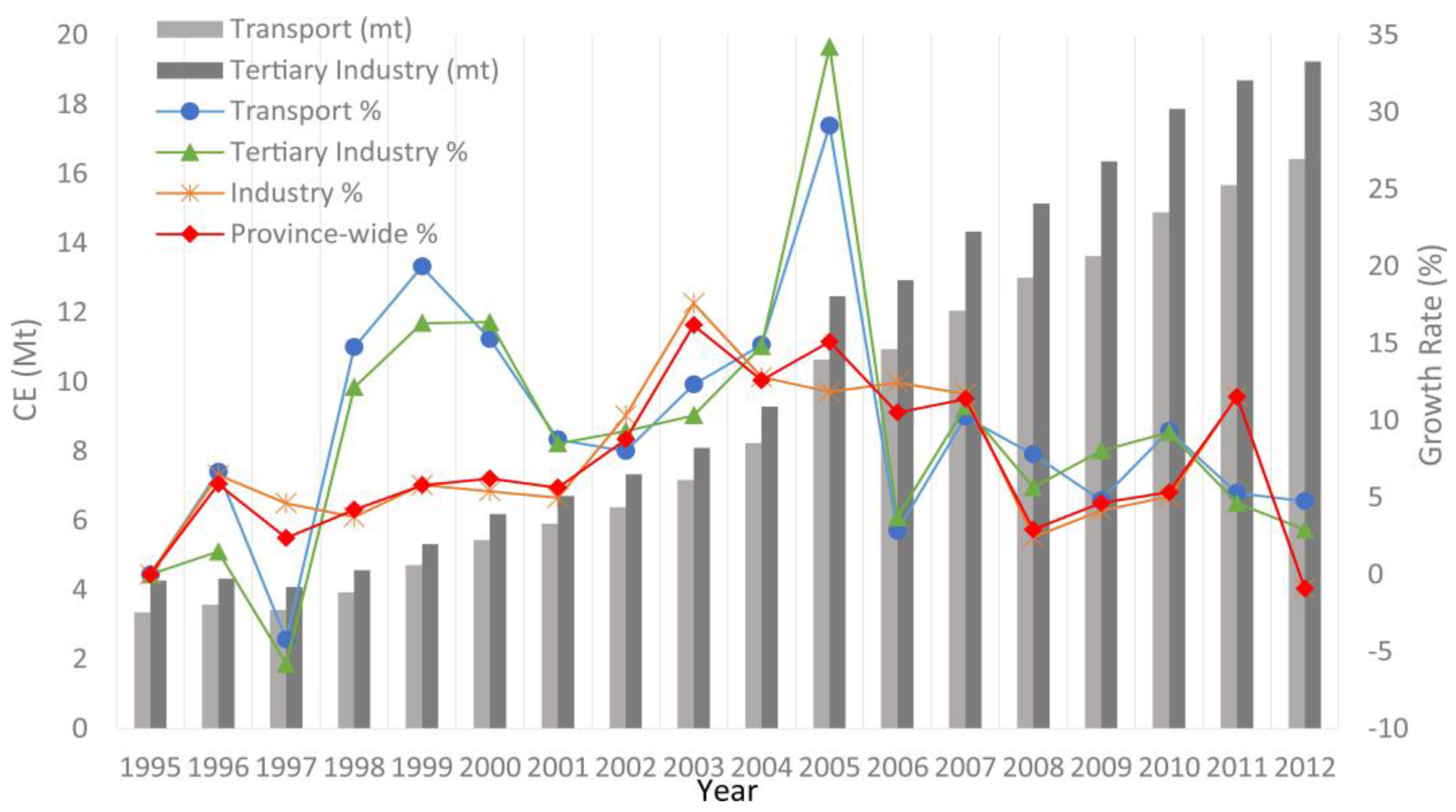
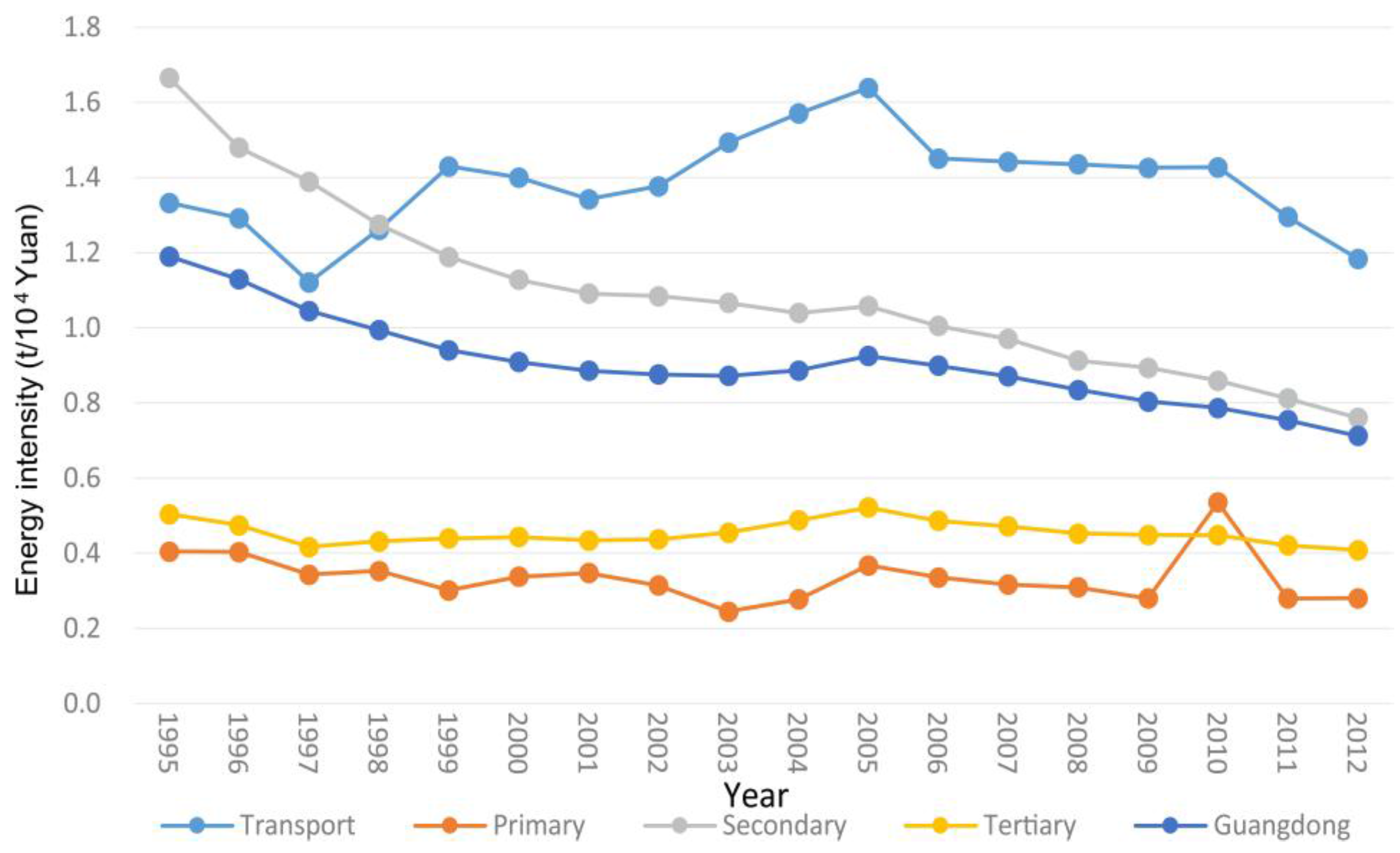
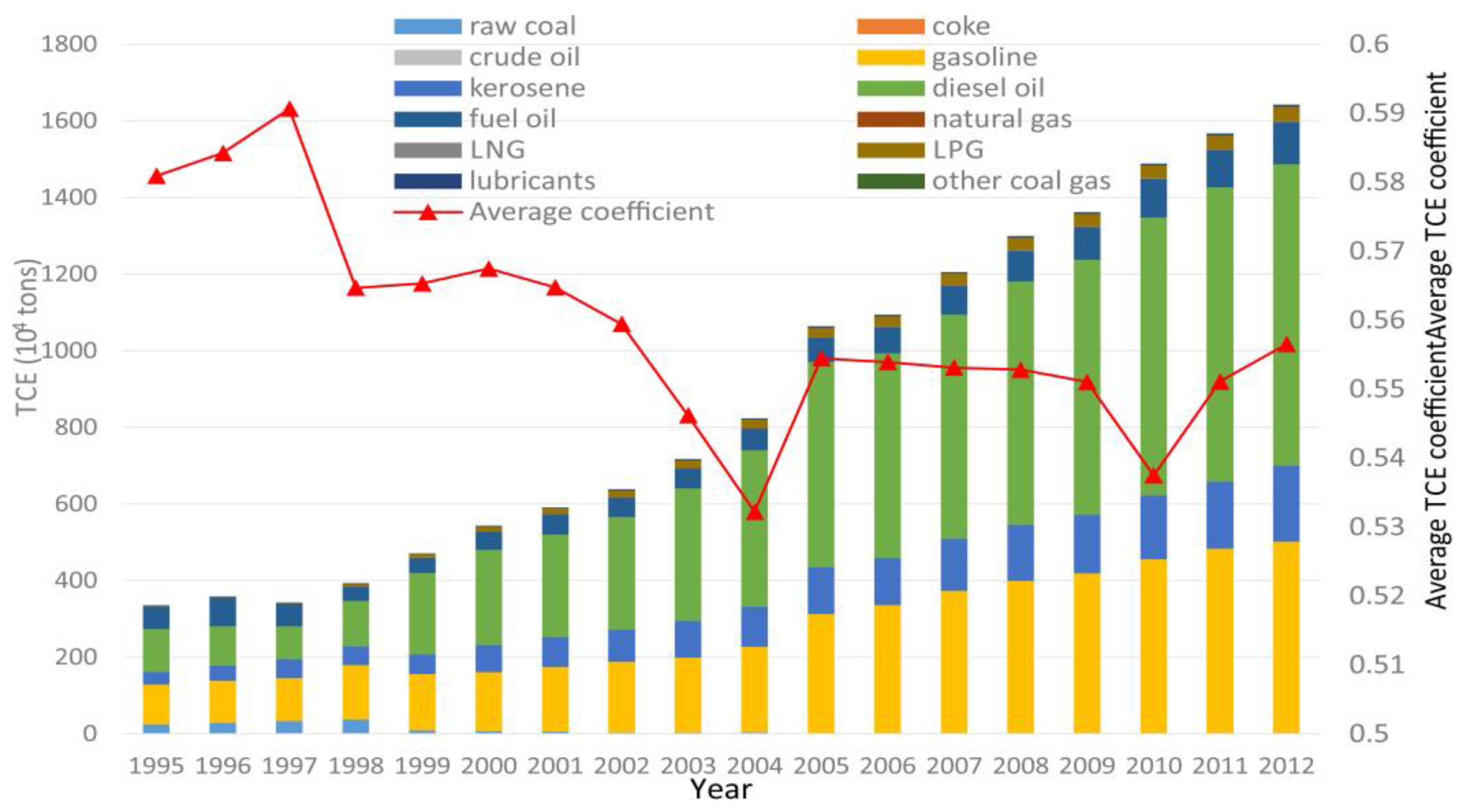
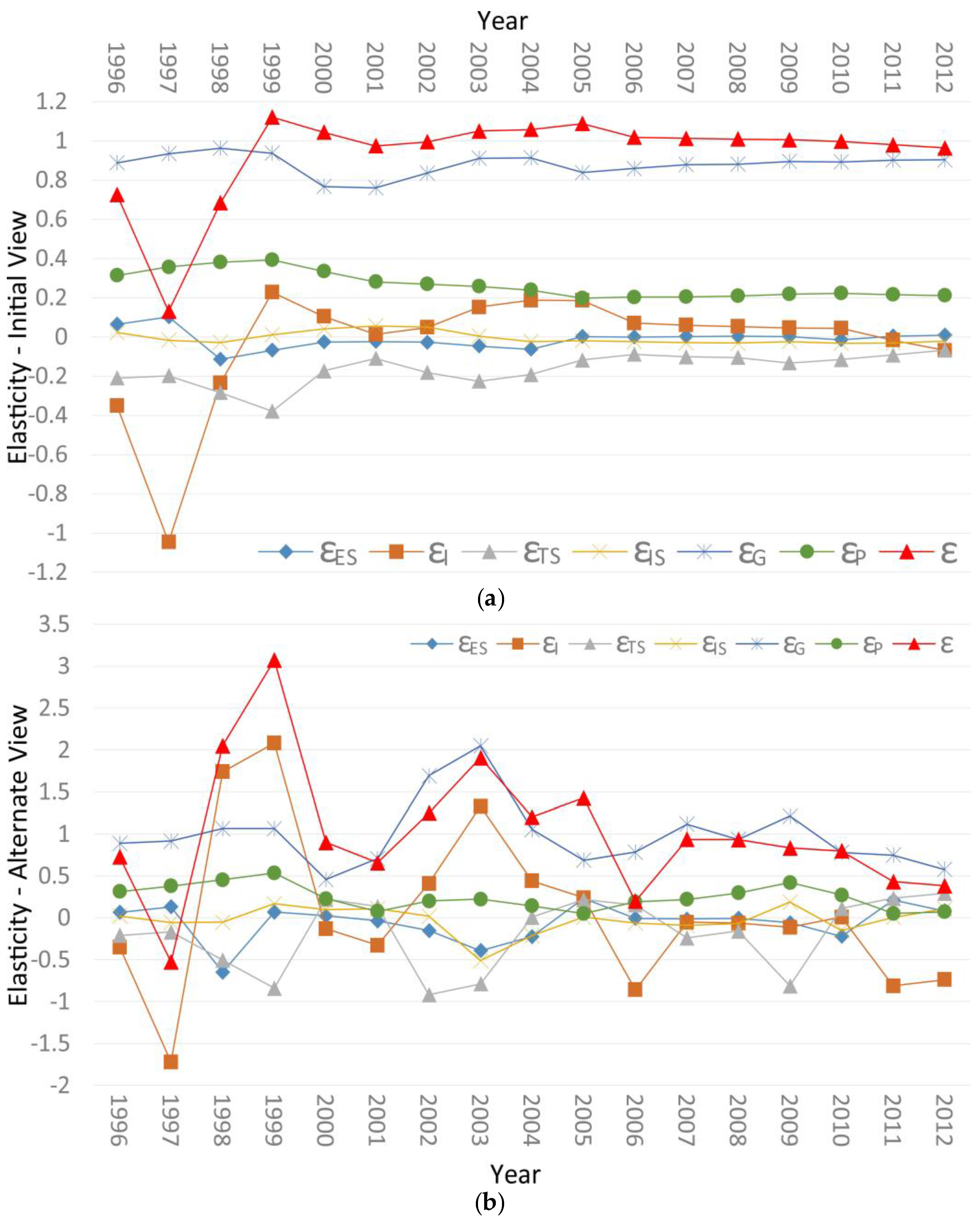
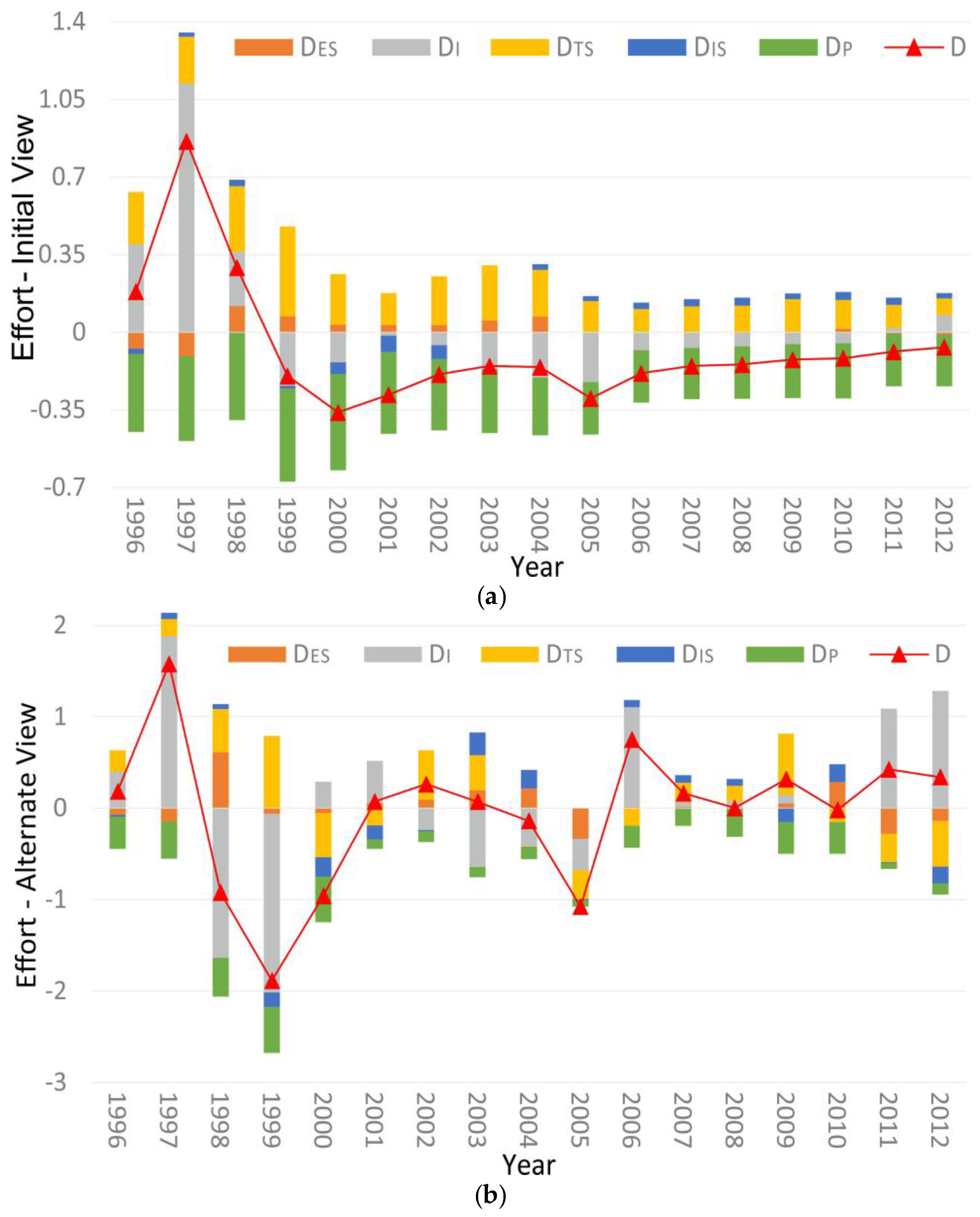
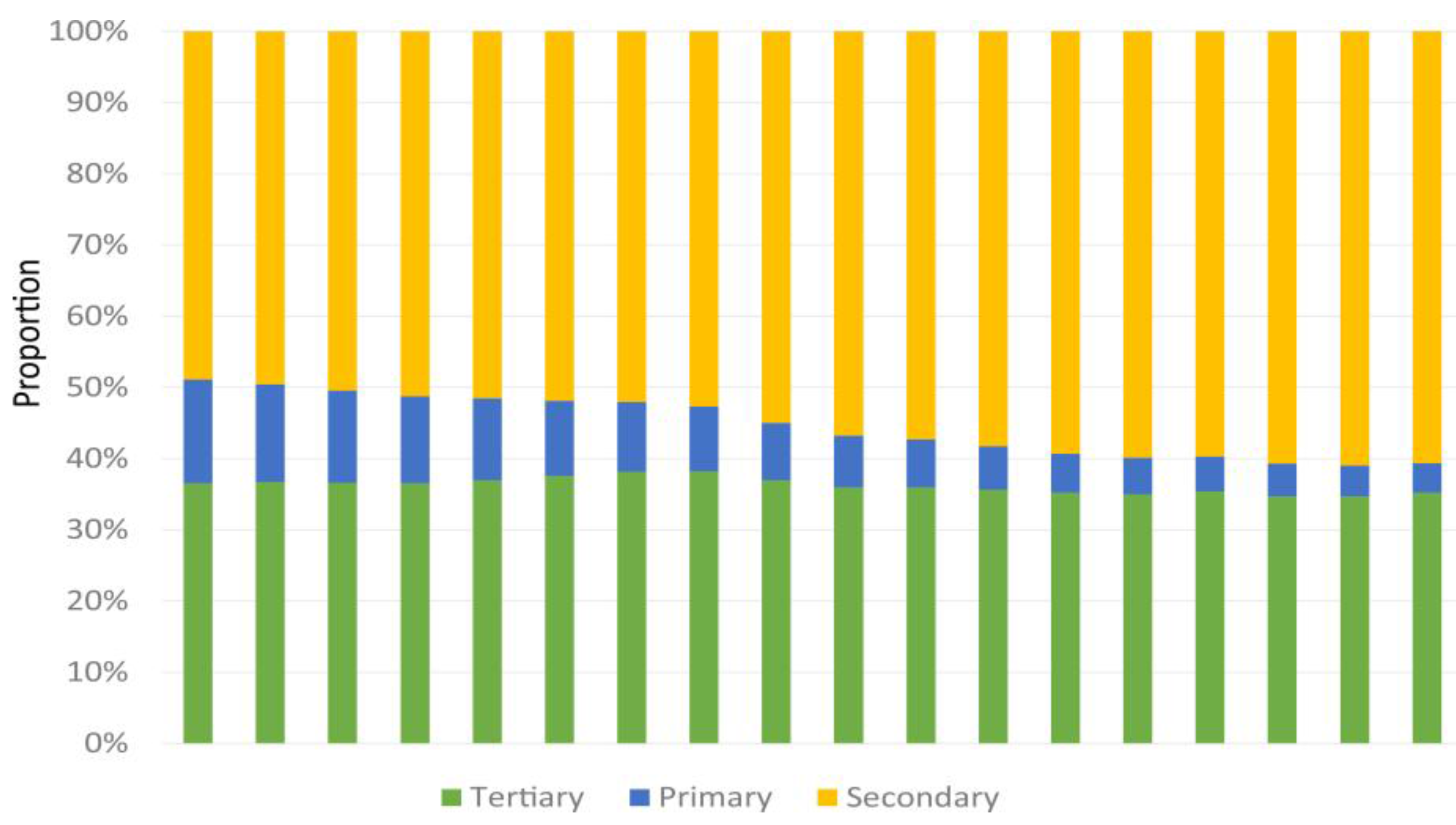
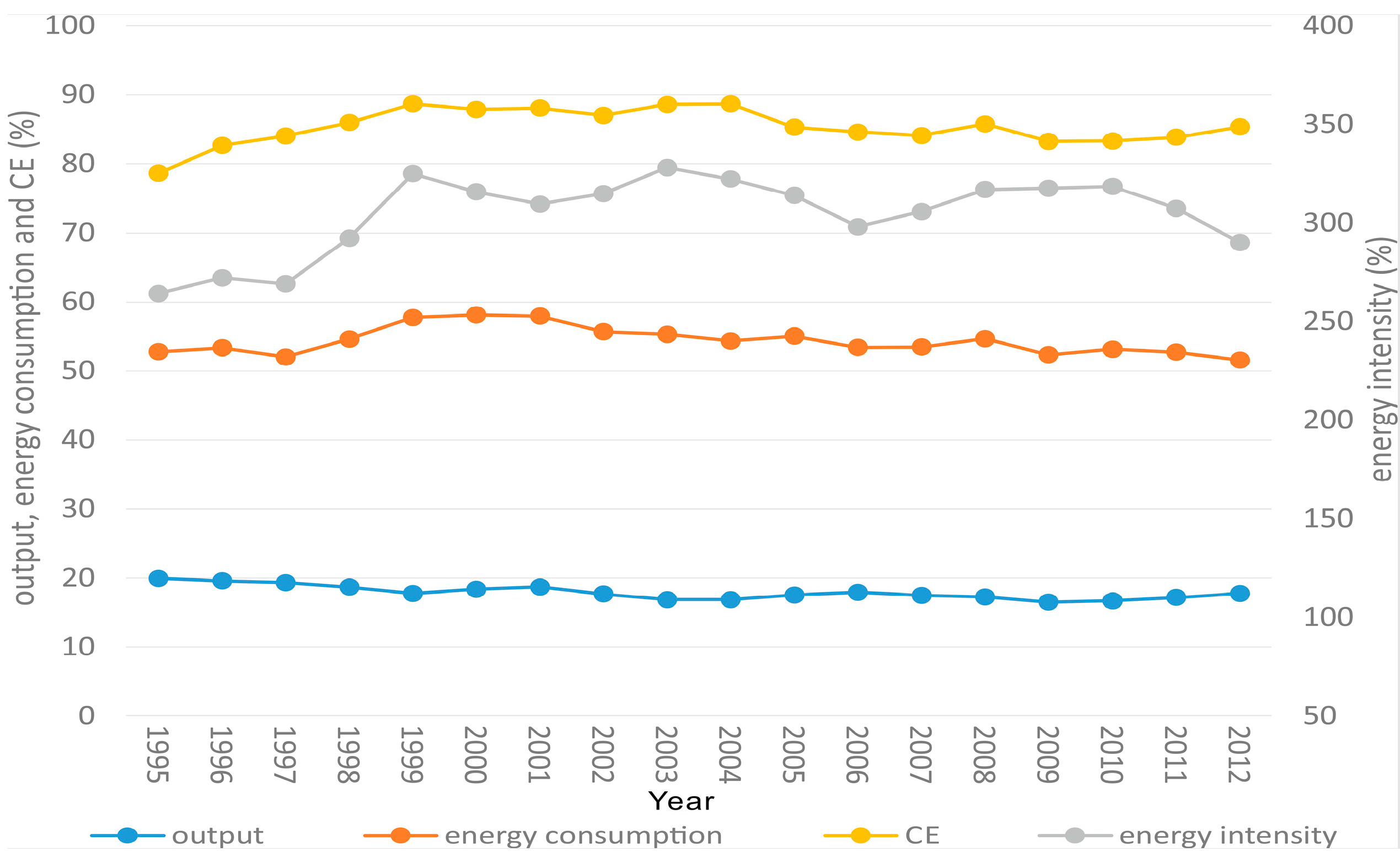
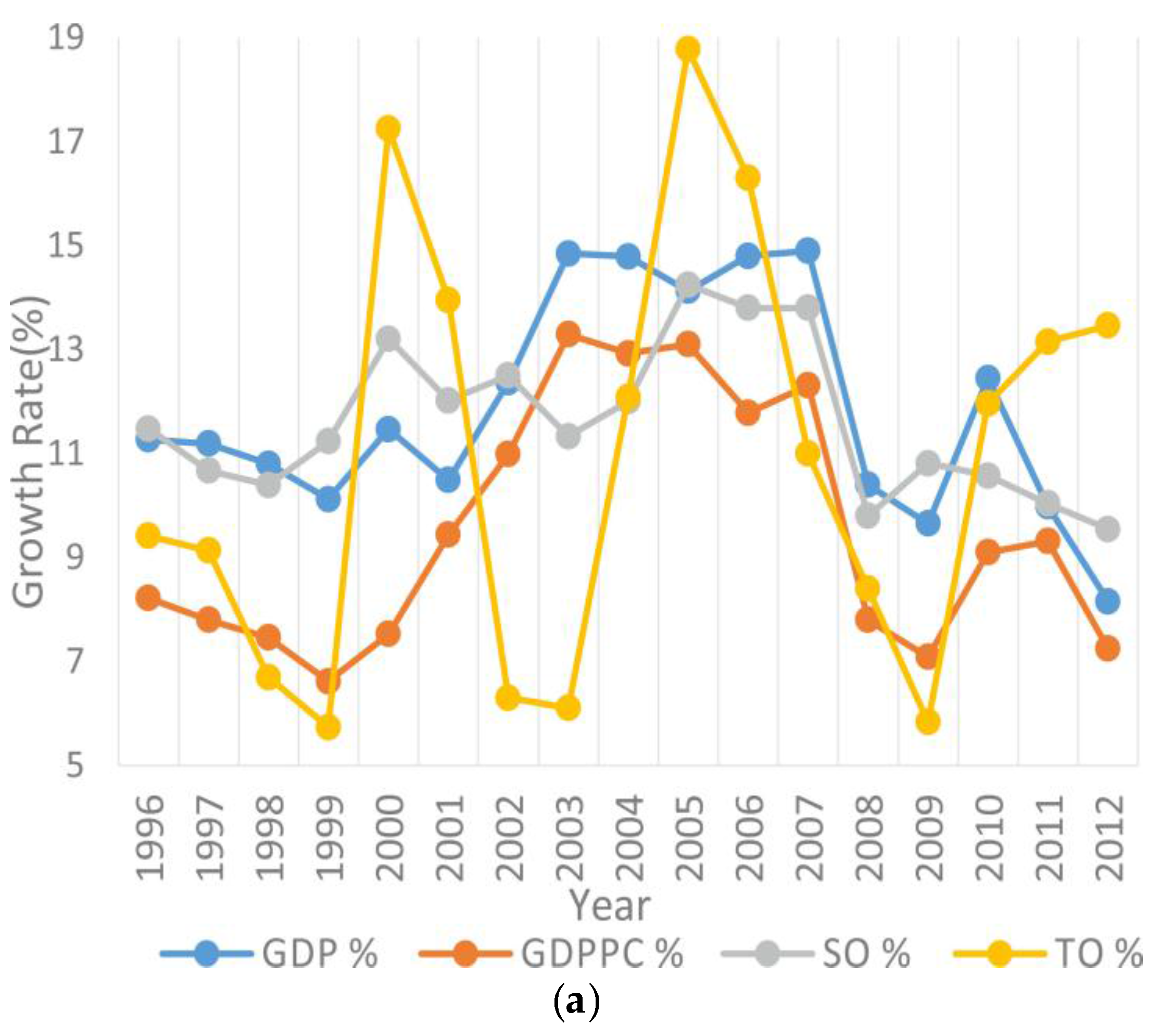
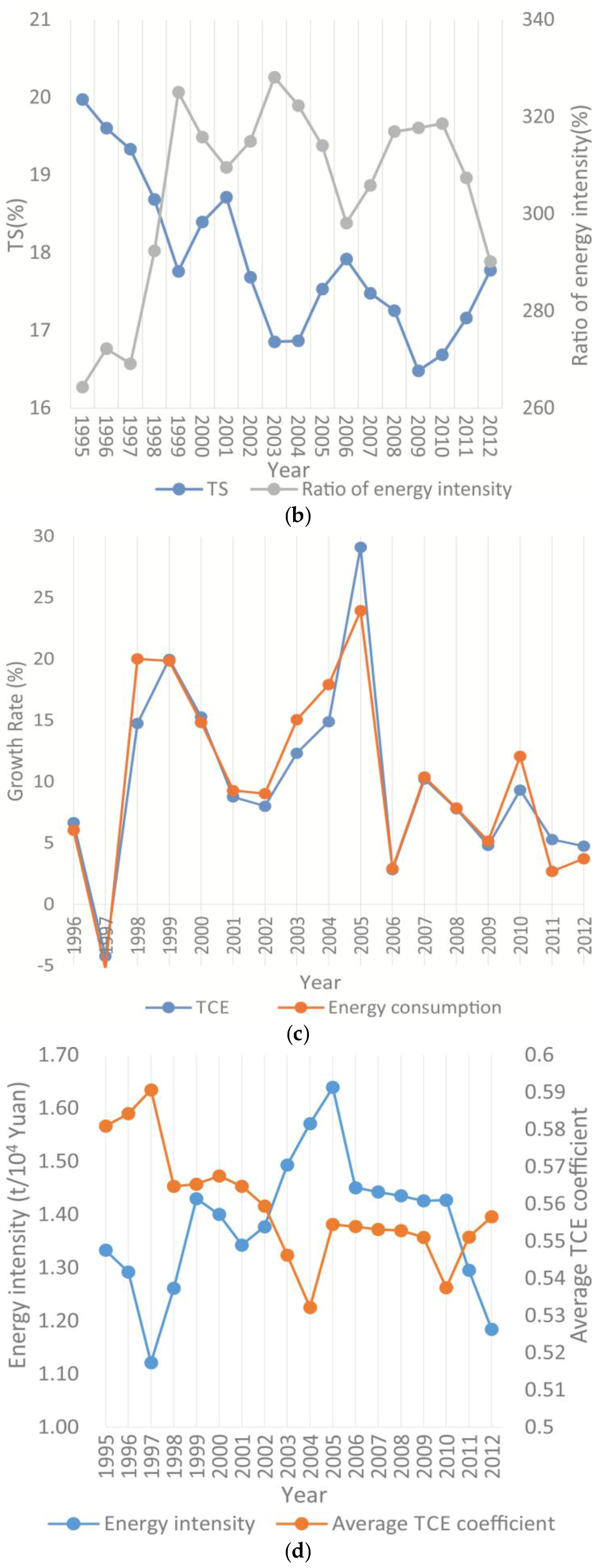
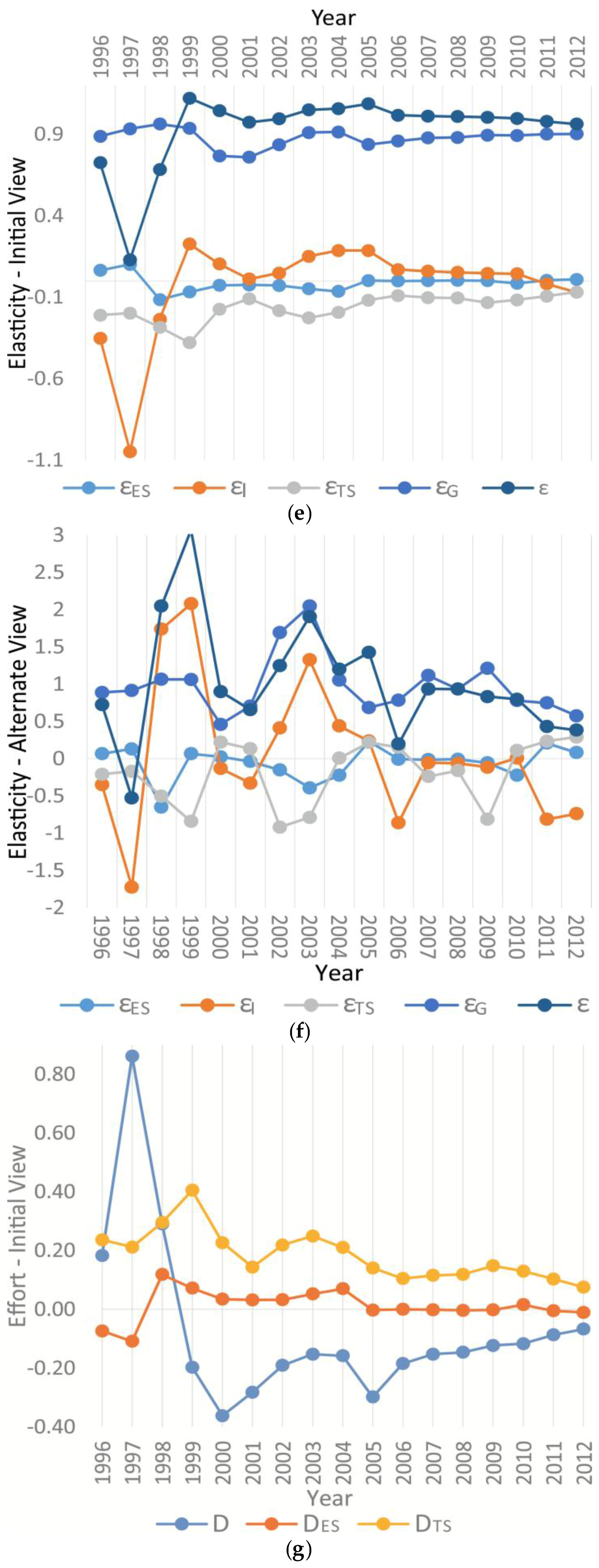
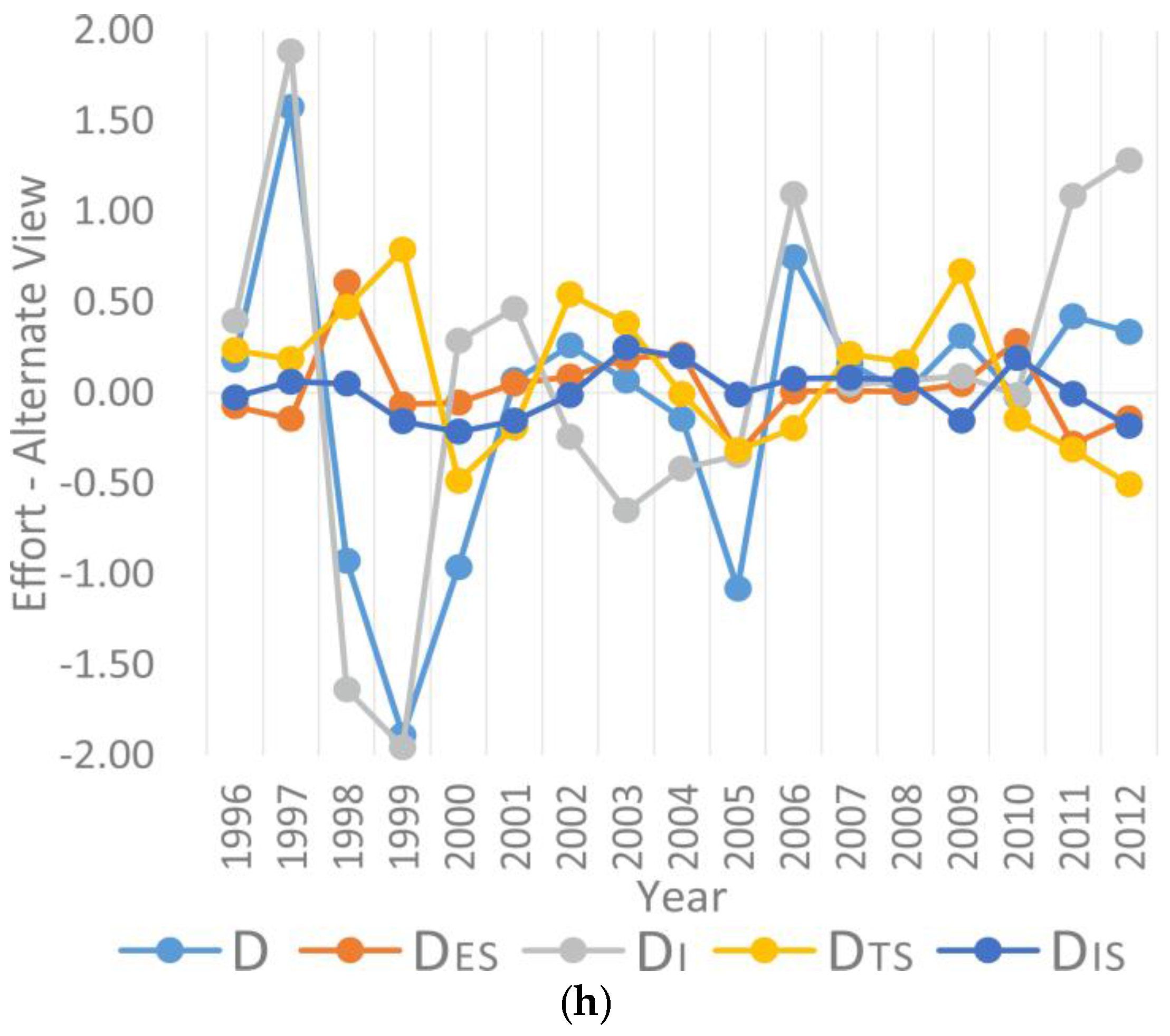
| Time Series | Initial | Alternate | ||||||||||
|---|---|---|---|---|---|---|---|---|---|---|---|---|
| 0 | t | ΔCE | ΔTO | ε | State | 0 | t | ΔCE | ΔTO | ε | State | |
| 1 year | 1995 | 1996 | 22.33 | 40.78 | 0.73 | WD | 1995 | 1996 | 22.33 | 40.78 | 0.73 | WD |
| 1995 | 1997 | 7.21 | 84.08 | 0.13 | SD | 1996 | 1997 | -15.11 | 43.29 | -0.53 | SD | |
| 1995 | 1998 | 57.70 | 118.70 | 0.68 | WD | 1997 | 1998 | 50.49 | 34.62 | 2.05 | END | |
| 1995 | 1999 | 136.22 | 150.34 | 1.12 | EC | 1998 | 1999 | 78.52 | 31.64 | 3.07 | END | |
| 1995 | 2000 | 208.24 | 251.02 | 1.04 | EC | 1999 | 2000 | 72.02 | 100.68 | 0.90 | EC | |
| 1995 | 2001 | 255.81 | 346.48 | 0.97 | EC | 2000 | 2001 | 47.57 | 95.46 | 0.66 | WD | |
| 1995 | 2002 | 303.11 | 395.61 | 0.99 | EC | 2001 | 2002 | 47.30 | 49.13 | 1.25 | END | |
| 1995 | 2003 | 381.79 | 446.21 | 1.05 | EC | 2002 | 2003 | 78.68 | 50.60 | 1.91 | END | |
| 1995 | 2004 | 488.63 | 552.53 | 1.06 | EC | 2003 | 2004 | 106.85 | 106.32 | 1.20 | END | |
| 1995 | 2005 | 728.57 | 737.63 | 1.09 | EC | 2004 | 2005 | 239.93 | 185.10 | 1.43 | END | |
| 1995 | 2006 | 758.62 | 928.46 | 1.02 | EC | 2005 | 2006 | 30.05 | 190.83 | 0.20 | WD | |
| 1995 | 2007 | 870.37 | 1078.23 | 1.01 | EC | 2006 | 2007 | 111.76 | 149.77 | 0.94 | EC | |
| 1995 | 2008 | 964.36 | 1205.18 | 1.01 | EC | 2007 | 2008 | 93.99 | 126.95 | 0.93 | EC | |
| 1995 | 2009 | 1026.85 | 1300.76 | 1.00 | EC | 2008 | 2009 | 62.50 | 95.58 | 0.83 | EC | |
| 1995 | 2010 | 1153.78 | 1508.19 | 1.00 | EC | 2009 | 2010 | 126.93 | 207.43 | 0.80 | WD | |
| 1995 | 2011 | 1232.51 | 1763.50 | 0.98 | EC | 2010 | 2011 | 78.72 | 255.31 | 0.43 | WD | |
| 1995 | 2012 | 1306.94 | 2059.24 | 0.96 | EC | 2011 | 2012 | 74.43 | 295.74 | 0.38 | WD | |
| 6 years | 1995 | 2000 | 208.24 | 251.02 | 1.04 | EC | 1995 | 2000 | 208.24 | 251.02 | 1.04 | EC |
| 1995 | 2006 | 758.62 | 928.46 | 1.02 | EC | 2001 | 2006 | 502.81 | 581.98 | 1.08 | EC | |
| 1995 | 2012 | 1306.94 | 2059.24 | 0.96 | EC | 2007 | 2012 | 436.56 | 981.01 | 0.68 | WD | |
| 5-year plan | 1995 | 2000 | 208.24 | 251.02 | 1.04 | EC | 1995 | 2000 | 208.24 | 251.02 | 1.04 | EC |
| 1995 | 2005 | 728.57 | 737.63 | 1.09 | EC | 2000 | 2005 | 520.32 | 486.60 | 1.18 | EC | |
| 1995 | 2010 | 1153.78 | 1508.19 | 1.00 | EC | 2005 | 2010 | 425.22 | 770.56 | 0.72 | WD | |
| 1995 | 2012 | 1306.94 | 2059.24 | 0.96 | EC | 2010 | 2012 | 153.15 | 551.05 | 0.42 | WD | |
| Year | Initial | Alternate | ||||||||||||
|---|---|---|---|---|---|---|---|---|---|---|---|---|---|---|
| εES | εI | εTS | εIS | εG | εP | ε | εES | εI | εTS | εIS | εG | εP | ε | |
| % | % | % | % | % | % | % | % | % | % | % | % | % | % | |
| 1996 | 8.98 | −48.45 | −28.97 | 2.95 | 122.40 | 43.09 | 100 | 8.98 | −48.45 | −28.97 | 2.95 | 122.40 | 43.09 | 100 |
| 1997 | 78.24 | −808.70 | −152.86 | −13.13 | 721.21 | 275.25 | 100 | −25.00 | 327.04 | 32.27 | 10.88 | −173.57 | −71.64 | 100 |
| 1998 | −16.74 | −34.42 | −41.63 | −4.07 | 141.04 | 55.82 | 100 | −31.72 | 84.93 | −24.59 | −2.69 | 51.95 | 22.13 | 100 |
| 1999 | −6.01 | 20.20 | −33.82 | 1.01 | 83.54 | 35.08 | 100 | 2.17 | 67.70 | −27.40 | 5.43 | 34.63 | 17.48 | 100 |
| 2000 | −2.53 | 9.97 | −16.66 | 3.85 | 73.43 | 31.94 | 100 | 2.78 | −14.69 | 24.69 | 10.90 | 51.03 | 25.29 | 100 |
| 2001 | −2.50 | 1.26 | −11.23 | 5.65 | 78.00 | 28.82 | 100 | −5.74 | −49.95 | 20.39 | 16.41 | 107.52 | 11.38 | 100 |
| 2002 | −2.75 | 4.92 | −18.37 | 5.11 | 83.99 | 27.10 | 100 | −12.22 | 32.85 | −73.60 | 1.47 | 135.39 | 16.11 | 100 |
| 2003 | −4.55 | 14.45 | −21.62 | 0.36 | 86.77 | 24.60 | 100 | −20.58 | 69.60 | −41.35 | −26.74 | 107.38 | 11.69 | 100 |
| 2004 | −6.04 | 17.65 | −18.19 | −2.33 | 86.37 | 22.54 | 100 | −18.67 | 36.49 | 0.54 | −17.67 | 87.51 | 11.79 | 100 |
| 2005 | 0.20 | 17.13 | −10.83 | −1.72 | 77.04 | 18.19 | 100 | 16.12 | 16.61 | 15.20 | 0.41 | 48.12 | 3.54 | 100 |
| 2006 | 0.00 | 6.87 | −8.83 | −2.39 | 84.40 | 19.95 | 100 | −3.54 | −438.52 | 78.01 | −31.41 | 399.91 | 95.55 | 100 |
| 2007 | 0.13 | 5.93 | −10.03 | −2.93 | 86.75 | 20.16 | 100 | −1.49 | −5.80 | −25.61 | −9.89 | 119.33 | 23.47 | 100 |
| 2008 | 0.30 | 5.24 | −10.39 | −3.16 | 87.27 | 20.73 | 100 | −0.71 | −6.74 | −17.10 | −7.26 | 100.06 | 31.75 | 100 |
| 2009 | 0.18 | 4.62 | −13.20 | −2.33 | 89.05 | 21.67 | 100 | −6.94 | −13.79 | −97.87 | 22.42 | 145.77 | 50.41 | 100 |
| 2010 | −1.41 | 4.42 | −11.63 | −3.28 | 89.54 | 22.37 | 100 | −27.89 | 1.05 | 14.00 | −18.86 | 97.76 | 33.93 | 100 |
| 2011 | 0.44 | −1.79 | −9.48 | −3.14 | 92.00 | 21.98 | 100 | 48.48 | −188.31 | 54.12 | 0.94 | 172.90 | 11.87 | 100 |
| 2012 | 0.96 | −7.19 | −7.09 | −2.28 | 93.71 | 21.88 | 100 | 21.21 | −193.52 | 75.80 | 27.49 | 150.83 | 18.19 | 100 |
| ME97 1 | −1.96 | 1.30 | −17.00 | −0.54 | 90.96 | 27.24 | 100 | −1.86 | −40.66 | −3.36 | −1.63 | 120.78 | 26.73 | 100 |
| Factor | Indicators | Variation Pattern of 5-Year Plans |
|---|---|---|
| Economy |
| Always high, much higher in the final year of every plan |
| ||
| “∪”-shape, with minimum values in the middle of each plan | |
| ||
| Environment |
| Minimum values at the beginning of each plan, rising towards a high level near the end |
| ||
| Generally showing“∪”-shapes, trough of 11th 5-Year Plan delayed | |
| Comprehensiveness |
| “∩"-shape, with maximum values in the middle of each plan |
| ||
| ||
| Peaks around 1995, 1999, 2005 and 2010, close to the ending of each plan |
© 2016 by the authors; licensee MDPI, Basel, Switzerland. This article is an open access article distributed under the terms and conditions of the Creative Commons Attribution (CC-BY) license (http://creativecommons.org/licenses/by/4.0/).
Share and Cite
Zhao, Y.; Kuang, Y.; Huang, N. Decomposition Analysis in Decoupling Transport Output from Carbon Emissions in Guangdong Province, China. Energies 2016, 9, 295. https://doi.org/10.3390/en9040295
Zhao Y, Kuang Y, Huang N. Decomposition Analysis in Decoupling Transport Output from Carbon Emissions in Guangdong Province, China. Energies. 2016; 9(4):295. https://doi.org/10.3390/en9040295
Chicago/Turabian StyleZhao, Yalan, Yaoqiu Kuang, and Ningsheng Huang. 2016. "Decomposition Analysis in Decoupling Transport Output from Carbon Emissions in Guangdong Province, China" Energies 9, no. 4: 295. https://doi.org/10.3390/en9040295
APA StyleZhao, Y., Kuang, Y., & Huang, N. (2016). Decomposition Analysis in Decoupling Transport Output from Carbon Emissions in Guangdong Province, China. Energies, 9(4), 295. https://doi.org/10.3390/en9040295






